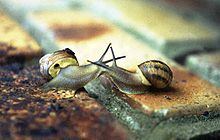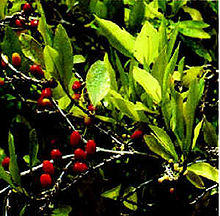- Muisca mythology
-
 Chia Goddess Preliminary Sketch by Alonso Neira Martinez
Chia Goddess Preliminary Sketch by Alonso Neira Martinez
Muisca mythology refers to the pre-Columbian beliefs of the Muisca culture about the origin and organization of the universe.
Contents
Creation of the universe
Bague (“the Grandmother”) is a non-material principle of creation, the will, the thought and the imagination of all the things to come. She is a similar concept to the principle of tao in the Chinese mythology.
The time of unquyquie nxie (the first thought) is the time of the cosmic origin, when the thoughts of Bague became actions. This is the time when Bague created the Builders of the Universe and ordered them to create.
The Builders
The first gods, constructors of the universe built the first Cuca or ceremonial temple. They were: Bachué (The one with naked breasts): The mother goddess, who raised from the underworld to give birth to the human race. Cuza (The one who is like the night): The male principle of creation. Chibchachum (the one who holds the earth). The universal legislator. Bochica (the father of civilization) Nemcatacoa and the Chiminigagua trinity deity, constituted by Chí, Chímini and Chiminigagua.
The gods danced a very long dance (Sas quyhynuca), with the music of the Fo drum, in the first ceremony. This ceremony gave origin to the space and time. Then, the gods created the first materials of the universe: Fiva (the air), Faova (the cosmic cloud) and Ie (the smoke). Then, they created the six directions of the material dimension, and in the middle of the emptiness, they created the center of power Tomsa (bellybutton of the universe). But, still the universe had no consistence, and they waited many bxogonoas eons until the sas bequia, the beginning of the world.
The beginning of the world
The World starts with Chimi (“the pulp”), the first material object in the world. Then, in the inners of Tomsa, were incubated the embryos of Stars, embryos of land and embryos of stone. When Tomsa was full, the seeds of the earth emerged and the remains were thrown away, forming the Milky Way. The elements were distributed to the deities. The heat to Sua – the sun -, the cold to Chía – the moon-, and the clouds and smoke to the earth, but all the things were still seeds and nothing was germinated. Then, Mnya, the gold, the energy, was united with Chimi, the pulp, and became Chímini, the creative force, which caused the germination of the seeds of all things.
The Great flood
Due to transgressions against the divine laws, Chibchachum brought forth a flood that covered the world and nearly destroyed the human race. Then, the protective god Bochica drove away the waters through the Tequendama Falls, and taught humans the basis of civilization, agriculture, religion, the arts, and crafts. When he was about to leave to his heavenly kingdom, the rainbow appeared and Bochica announced his second coming, far away in the future, in an event marked by death and disease. These events are similar to the biblical histories of Genesis and Apocalypse. .
The gods and sacred places
The pre-Columbian inhabitants of Colombia worshipped many forces of nature, animals and plant species, besides the main gods. Among others:
- Aba: The maize
- Bachué: The mother of mankind
- Bague: Great grandmother, the mind of the universe
- Biza: The snail
- Bochica: The savior
- Bxogonoa: The period of a generation
- Cona: The mochila bag
- Cuza: The one that is like the night
- Chia: The moon
- Chibchachum: The World Holder.
- Chíe: The urtica plant
- Chiguacá: The verdolaga plant Portulaca oleracea
- Chiinegüi: The small captain fish
- Chimi: The pulp, the first being
- Chímini: The golden Light.
- Chiminigagua: The golden pulp, the force of creation
- Chuhuia: The mouse
- Chyquy: The priests of the calendar
- Cuza fiba, Chuchaviva: The Rainbow (chuquy) deity. The sign of death.
- Fanzaquia: The harvest.
- Faoba: The cloud
- Fagua: The star, the morning star
- Fiva: The air
- Fo: The spirit of music
- Fupqua: The crab
- Gacha: The chicha pot
- Gata: The fire
- Guaquy: The mastuerzo plant Lepidium sativum
- Guayacán: The guayacan tree Caesalpinia spp.
- Guamuyhyca: The black captain fish
- Guayque: The chief
- Guecha, Güecha: The warrior
- Gue mny muy: The house of the sacred gold ornaments
- Hayo: The coca plant
- Ie: The path; the smoke
- Iomza: The potato
- Iosua: The tadpole
- Itugue: The emptiness
- Mnya: The gold, the energy
- Mocoba: The frailejón plant
- Mohanes: The priests of water
- Muyquyta, Muequetá: The sacred land. (The Bacata savannah, placement of the modern city of Bogotá.)
- Nemcatacoa: The protector of the loom
- Opaguegue: House of the moon
- Hosca: The tobacco plant
- Poporo: Important device in the ceremony of Hayo (coca chewing).
- Quemes: The Messengers
- Quincha: The hummingbird
- Quizo: The perdix bird
- Saga: The ceremonial fast
- Sie: The water
- Simte: The owl
- Sua: The sun
- Sue: The parrot, husband of Bachué, which is sometimes depicted as a child in her arms.
- Suhuzy mny: The house of the war ornaments
- Sumguy: The tortola bird Zenaida auriculata
- Sumne: The duck
- Suquysca: The cerraja plant Sonchus spp.
- Tegua: The healer
- Timaná: The ceremonial cup
- Titua: House of feathers
- Tymanzo: The vulture
- Tyba: The owner of the knowledge.
- Tyhyquy: The borrachero plant Datura stramonium
- Uaia, Guaia: The mother, the lady
- Ubzaque, Uzaque: Great chiefs
- Yopo: The plant gate of the knowledge
References
- http://www.observatorio.unal.edu.co/arqueoastronomia/articulos/bachue.pdf
- http://www.colombiaaprende.edu.co/html/sitios/1610/article-72982.html
See also: Colombian folkloreExternal links
- Mitología Indígena Colombian government page about indigenous mythology.
Categories:- Colombian culture
- History of Colombia
- Mythology of the indigenous peoples of North America
- Muisca
Wikimedia Foundation. 2010.









